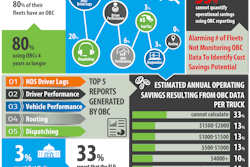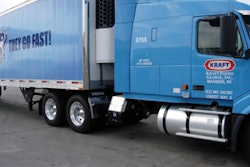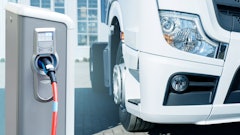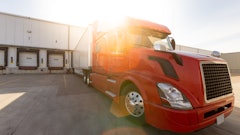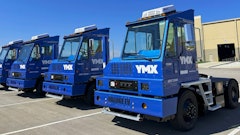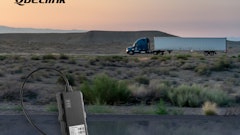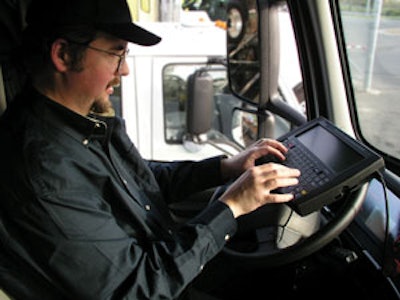
With today's rising fuel costs and a lack of drivers, transportation managers are looking for ways to run their fleets more efficiently. As a result, more and more food companies are turning to onboard systems to help increase driver performance and safety.
However, with the high cost of start-up, companies are diligently looking for the correct processes and procedures that will enable them to get the fastest return on their investment possible.
The first step a company can take to guarantee that it will see a faster ROI on its onboard systems investment involves choosing the right system.
"Many are not able to provide good value with regards to reporting and the use of the data," says James Griffin, executive vice president, research and development, at XATA, an Eden Prairie, MN-based provider of on-demand fleet software and services. "Companies should pick a system which gives them what they need for their business with regards to reporting and industry benchmarks, as well as the information they need access to."
Integration is also an issue when selecting systems. Buyers need to do their due diligence and make sure whichever onboard system they choose will allow them to integrate their own payroll, dispatching, financial and routing systems into it. Being able to share data seamlessly will aid in seeing faster returns.
Implementation Processes
Once a company has chosen the onboard solution that is right for its needs, making sure that the proper implementation processes are in place will help ensure that the ROI cycle is shorter. Companies such as XATA have implementation methodologies that they walk customers through, strategies which allow customers to deploy new processes in their organizations on a timely basis.
"It starts at the beginning," says Jim Showalter, director of client management for XATA. "What type of hardware kits do they need? How do we schedule installations and make sure we hit those dates and how do we schedule training on the heels of that? It ends with determining whether or not the customer actually achieves the ROI."
He says that the implementation procedure will allow clients to understand how to get data into the system, as well as how to interpret it and mine it so they can use it to make and drive critical business decisions.
"Implementing an onboard system is total change management," says Bernie Cassetori, vice president, fleet management, at U.S. Foodservice, a Columbia, MD-based food distributor with over 70 distribution centers across America. The company has been using XATA's onboard system solution since 2005. "We were doing things on paper before and suddenly we had all this electronic data available to us. Managing this change was the hardest part for us."
Cassetori installed 6,000 units in the U.S. Foodservice fleet. The process took a year-and-a-half and they went division-by-division, working from the top down.
"We sold the folks at the top of each division on what we wanted to do," he explains. "Then we held them accountable for getting good quality data out of the drivers."
Division heads would then hold their drivers accountable, making sure that they were properly logging on and off of the system. Employees that wouldn't buy into the new system had to be let go.
"With an onboard system like ours, you can pick from 20 to 25 different applications," says Peoplenet's Brian Mclaughlin, executive vice president for the Chaska, MN-based provider of mobile communications and onboard computing systems. "You really need to pick the top three to five things that you want to go after first."
He suggests that a company that tries to accomplish all of its goal at once is going to fail to achieve any of them. His company's Professional Services team goes on site to clients' facilities in order to help them choose which goals to go after first. The team will ask clients what they're specifically looking to get out of a new system-typically it's a safety, security, efficiency or compliance related goal. Once this is determined, it's a matter of determining strategies to meet the goal.
"Try to determine what your biggest pain point is," suggests Frank Moreno, vice president of marketing for Cadec, a Manchester, NH-based provider of advanced mobile-technology services and solutions. "It may be customer service, compliance or reducing paper. Whatever it is, start with that and once that's accomplished, build on that."
Being able to make greater use of available resources, through the deployment of an onboard system is a prime method for seeing a quicker ROI.
Norm Ellis, VP and general manager for transportation and logistics at Qualcomm-a San Diego, CA company that provides wireless and asset management solutions-tells about implementing a system with the largest potato chip manufacturer in the U.S.
"They said they were at 80 percent efficiency on their trailers and thought if they could get to 90 percent they would have a great ROI. We did the pilot for 60 days and it came out that their actual utilization was 62 percent."
He says that the company wasn't accounting for the fact that some managers in the field were hiding trailers from the system, in order to make sure they had access to them when they needed them. When all the trailers were accounted for in the pilot test, the overall utilization dropped.
"Now, as their business grows, they won't need to add any more trucks," he says. "They can grow over the next year by 10 to 12 percent and not have any capital expenditures."
One of the quickest ways to recoup the cost of an onboard system is by reducing a fleet's overall fuel consumption and increasing miles per gallon. One way a system does this is by reducing out-of-route miles per truck.
"Drivers have a tendency to stray off their appointed routes from time-to-time, in order to run personal errands," says Ken Yeomans, director of professional services for XATA. "They could drive 20 miles of their route and 20 miles back, so not only have they burned an hour of time, but they also burn all of that fuel as well."
Thanks to the tracking capabilities offered by onboard systems, companies can take steps to restrain drivers from using company trucks for personal use.
Hours Of Service
Another way that onboard systems can help fleets save money is through maintaining their drivers' hours of compliance, in order to meet DOT regulations. Fines can run companies in the thousands of dollars if one of their drivers is over his hours.
"Our system tracks a driver's available hours, so that when you're planning a route, you can see what hours they have available," explains Chuck Motta, product manager for Cadec. "If you have a large fleet of drivers, you can put the ones with the most hours of service left in routes that may take longer and thereby save yourself a lot of fines."



